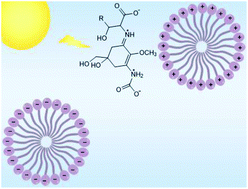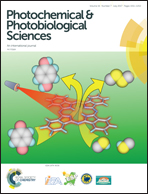Photophysicochemical characterization of mycosporine-like amino acids in micellar solutions
Abstract
The properties and photochemical and photophysical behavior of the mycosporine-like amino acids (MAAs) shinorine and porphyra-334 were experimentally evaluated in solutions of direct ionic micelles as simple biomimicking environments. The preferential partition of the natural molecules in the aqueous phase of sodium dodecyl sulfate (SDS) or cetyltrimethylammonium chloride (CTAC) micellar systems is confirmed. Although the proton dissociation of the carboxylic groups in the MAAs is slightly inhibited in CTAC solutions, the molecules are predicted to be in the form of zwitterions in all the explored media around physiological pH. The increase in the fluorescence quantum yield, emission lifetime and stationary anisotropy in the presence of CTAC micelles suggest electrostatic attractions of the MAAs with the surface of the cationic micelles. Consistently, the triplet–triplet absorption spectra in CTAC solutions reveal the typical environmental features of the micellar interface, while in the presence of SDS they are similar to those determined in neat water. Finally, the photostability of the MAAs increases in the micellar systems, more noticeably in the case of CTAC. It is concluded that the ability of the two MAAs to act as UV screens is susceptible to the influence of electrostatic interactions with organized microheterogeneous environments.



 Please wait while we load your content...
Please wait while we load your content...